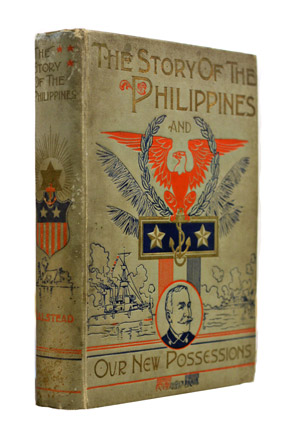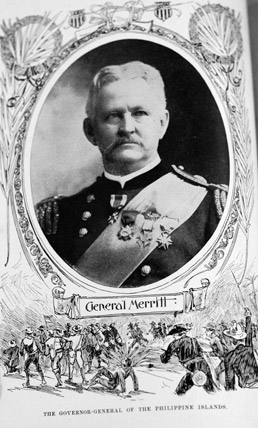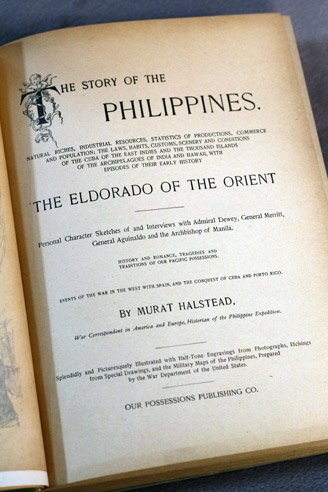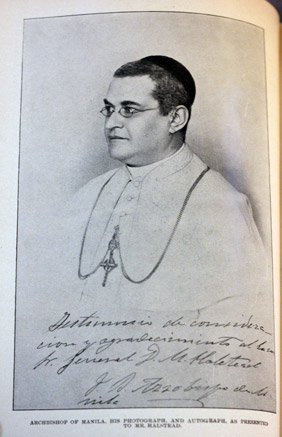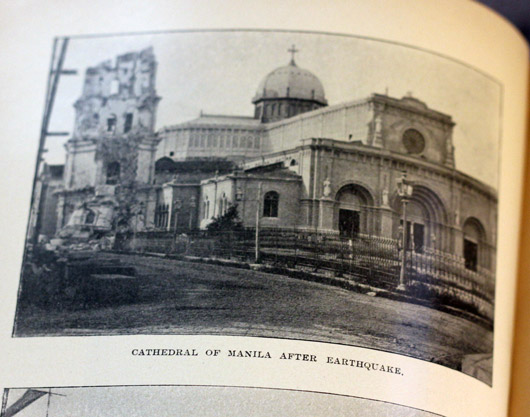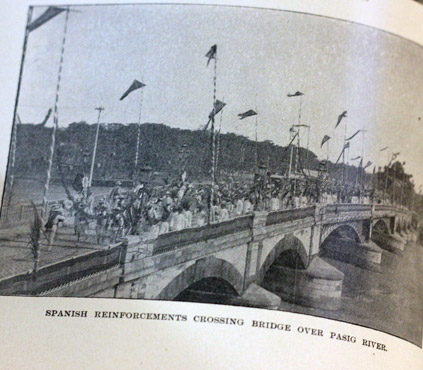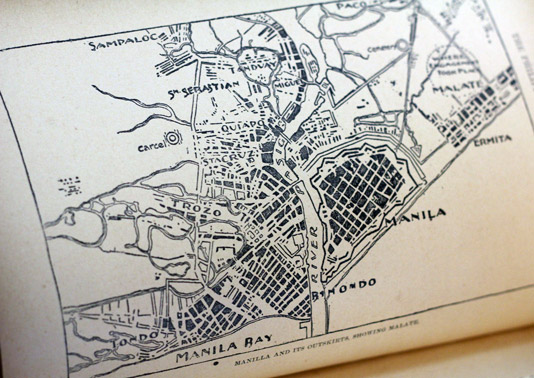Title: The Story of the Philippines and Our New Possessions, Including The Ladrones, Hawaii, Cuba and Porto Rico
Author: Murat Halstead, War Correspondent in America and Europe, Historian of the Philippine Expedition Chicago, 1898.
Publisher: Our Possessions Publishing Co, 1898. First edition.
Condition: Hardcover, decorative cloth. Very good condition. Slight wear and soiling. Firmly bound. Splendidly and Picturesquely Illustrated with Half-Tone Engravings from Photographs, Etchings from Special Drawings, and the Military Maps of the Philippines, Prepared by the War Department of the United States.
The Story of the Philippines.
Natural Riches, Industrial Resources, Statistics of Productions,
Commerce and Population; The Laws, Habits, Customs, Scenery and
Conditions of the Cuba of the East Indies and the Thousand Islands
of the Archipelagoes of India and Hawaii, With Episodes of Their
Early History
The Eldorado of the Orient
Personal Character Sketches of and Interviews with Admiral Dewey,
General Merritt, General Aguinaldo and the Archbishop of Manila.
History and Romance, Tragedies and Traditions of our Pacific
Possessions.
Events of the War in the West with Spain, and the Conquest of Cuba
and Porto Rico.
Contents
AUTHOR’S PREFACE
THE ORIGIN OF THIS STORY OF THE PHILIPPINES
CHAPTER I.
ADMIRAL DEWEY ON HIS FLAGSHIP.
A Stormy Day on Manila Bay–Call on Admiral Dewey–The Man in
White–He Sticks to His Ship–How He Surprised the Spaniards–Every
Man Did His Duty on May-Day–How Dewey Looks and Talks–What He Said
About War With Germany in Five Minutes–Feeds His Men on “Delicious”
Fresh Meat from Australia–Photography Unjust to Him
CHAPTER II.
LIFE IN MANILA.
Character of the Filipinos–Drivers Lashing Laboring Men in
the Streets–What Americans Get in Their Native Air–The Logic
of Destiny–Manila as She Fell Into Our Hands–The Beds in the
Tropics–A Spanish Hotel–Profane Yells for Ice–Sad Scenes in the
Dining Room–Major-General Calls for “Francisco”–A Broken-Hearted
Pantry Woman
CHAPTER III.
FROM LONG ISLAND TO LUZON.
Across the Continent–An American Governor-General Steams Through
the Golden Gate–He is a Minute-Man–Honolulu as a Health Resort–The
Lonesome Pacific–The Skies of Asia–Dreaming Under the Stars of the
Scorpion–The Southern Cross
CHAPTER IV.
INTERVIEW WITH GENERAL AGUINALDO.
The Insurgent Leader’s Surroundings and Personal Appearance–His
Reserves and Ways of Talking–The Fierce Animosity of the Filipinos
Toward Spanish Priests–A Probability of Many Martyrs in the Isle
of Luzon
CHAPTER V.
THE PHILIPPINE MISSION.
Correspondence with Aguinaldo About It–Notes by Senor Felipe
Agoncillo–Relations Between Admiral Dewey and Senor Aguinaldo–Terms
of Peace Made by Spanish Governor-General with Insurgents, December,
1897–Law Suit Between Aguinaldo and Arlacho–Aguinaldo’s Proclamation
of May 21, 1898
CHAPTER VI.
THE PROCLAMATIONS OF GENERAL AGUINALDO.
June 16th, 1898, Establishing Dictatorial Government–June 20th, 1898,
Instructions for Elections–June 23d, 1898, Establishing Revolutionary
Government–June 23d, 1898, Message to Foreign Powers–June 27th,
1898, Instructions Concerning Details–July 23d, 1898, Letter from
Senor Aguinaldo to General Anderson–August 1st, 1898, Resolution
of Revolutionary Chiefs Asking Recognition–August 6th, 1898, Message
to Foreign Powers Asking Recognition
CHAPTER VII.
INTERVIEW WITH ARCHBISHOP OF MANILA.
Insurgents’ Deadly Hostility to Spanish Priests–The Position of
the Archbishop as He Defined It–His Expression of Gratitude to the
American Army–His Characterization of the Insurgents–A Work of
Philippine Art–The Sincerity of the Archbishop’s Good Words
CHAPTER VIII.
WHY WE HOLD THE PHILIPPINES.
The Responsibility of Admiral Dewey–We Owe It to Ourselves to Hold
the Philippines–Prosperity Assured by Our Permanent Possession–The
Aguinaldo Question–Character Study of the Insurgent Leader–How
Affairs Would Adjust Themselves for Us–Congress Must Be Trusted to
Represent the People and Firmly Establish International Policy
CHAPTER IX.
THE PHILIPPINE ISLANDS AS THEY ARE.
Area and Population–Climate–Mineral Wealth–Agriculture–Commerce
and Transportation–Revenue and Expenses–Spanish Troops–Spanish
Navy–Spanish Civil Administration–Insurgent Troops–Insurgent Civil
Administration–United States Troops–United States Navy–United
States Civil Administration–The Future of the Islands
CHAPTER X.
OFFICIAL HISTORY OF THE CONQUEST OF MANILA.
The Pith of the Official Reports of the Capture of Manila, by
Major-General Wesley Merritt, Commanding the Philippine Expedition;
General Frank V. Greene, General Arthur McArthur, and General
Thomas Anderson, with the Articles of Capitulation, Showing How
8,000 Americans Carried an Intrenched City with a Garrison of 13,000
Spaniards, and Kept Out 14,000 Insurgents–The Difficulties of American
Generals with Philippine Troops
CHAPTER XI.
THE ADMINISTRATION OF GENERAL MERRITT.
The Official Gazette Issued at Manila–Orders and Proclamation of
Major-General Wesley Merritt, Who, as Commander of the Philippine
Expedition, Became, Under the Circumstances of the Capture of Manila,
the Governor of That City
CHAPTER XII.
THE AMERICAN ARMY IN MANILA.
Why the Boys Had a Spell of Homesickness–Disadvantages of the
Tropics–Admiral Dewey and His Happy Men–How Our Soldiers Passed
the Time on the Ships–General Merritt’s Headquarters–What Is Public
Property–The Manila Water Supply–England Our Friend–Major-General
Otis, General Meritt’s Successor
CHAPTER XIII.
THE WHITE UNIFORMS OF OUR HEROES IN THE TROPICS.
The Mother Hubbard Street Fashion in Honolulu, and That of Riding
Astride–Spoiling Summer Clothes in Manila Mud–The White Raiment
of High Officers–Drawing the Line on Nightshirts–Ashamed of Big
Toes–Dewey and Merritt as Figures of Show–The Boys in White
CHAPTER XIV.
A MARTYR TO THE LIBERTY OF SPEECH.
Dr. Jose Rizal, the Most Distinguished Literary Man of the Philippines,
Writer of History, Poetry, Political Pamphlets, and Novels, Shot on the
Luneta of Manila–A Likeness of the Martyr–The Scene of His Execution,
from a Photograph–His Wife Married the Day Before His Death–Poem
Giving His Farewell Thoughts, Written in His Last Hours–The Works
That Cost Him His Life–The Vision of Friar Rodriguez
CHAPTER XV.
EVENTS OF THE SPANISH-AMERICAN WAR.
No Mystery About the Cause of the War–The Expected and the Inevitable
Has Happened–The Tragedy of the Maine–Vigilant Wisdom of President
McKinley–Dewey’s Prompt Triumph–The Battles at Manila and Santiago
Compared–General Shafter Tells of the Battle of Santiago–Report of
Wainwright Board on Movements of Sampson’s Fleet in the Destruction of
Cervera’s Squadron–Stars and Stripes Raised Over Porto Rico–American
and Spanish Fleets at Manila Compared–Text of Peace Protocol
CHAPTER XVI.
THE PEACE JUBILEE.
The Lessons of War in the Joy Over Peace in the Celebrations
at Chicago and Philadelphia–Orations by Archbishop Ireland
and Judge Emory Speer–The President’s Few Words of Thrilling
Significance–The Parade of the Loyal League, and the Clover Club
Banquet at Philadelphia–Address by the President–The Hero Hobson
Makes a Speech–Fighting Bob Evans’ Startling Battle Picture–The
Destruction of Cervera’s Fleet–The Proclamation of Thanksgiving
CHAPTER XVII.
EARLY HISTORY OF THE PHILIPPINES.
The Abolishment of the 31st of December, 1844, in Manila–The Mystery
of the Meridian 180 Degrees West–What Is East and West?–Gaining and
Losing Days–The Tribes of Native Filipinos–They Had an Alphabet and
Songs of Their Own–The Massacre of Magellan–His Fate Like That of
Captain Cook–Stories of Long-Ago Wars–An Account by a Devoted Spanish
Writer of the Beneficent Rule of Spain in the Philippines–Aguinaldo
a Man Not of a Nation, But of a Tribe–Typhoons and Earthquakes–The
Degeneracy of the Government of the Philippines After It Was Taken
from Mexico–“New Spain”–The Perquisites of Captain-Generals–The
Splendor of Manila a Century Ago
CHAPTER XVIII.
THE SOUTHERN PHILIPPINES.
Important Facts About the Lesser Islands of the Philippine
Archipelago–Location, Size and Population–Capitals and
Principal Cities–Rivers and Harbors–Surface and Soil–People
and Products–Leading Industries–Their Commerce and Business
Affairs–The Monsoons and Typhoons–The Terrors of the Tempests and
How to Avoid Them
CHAPTER XIX.
SPECIFICATIONS OF GRIEVANCES OF THE FILIPINOS.
An Official Copy of the Manifesto of the Junta Showing the Bad Faith
of Spain in the Making and Evasion of a Treaty–The Declaration
of the Renewal of the War of Rebellion–Complaints Against the
Priests Defined–The Most Important Document the Filipinos Have
Issued–Official Reports of Cases of Persecution of Men and Women in
Manila by the Spanish Authorities–Memoranda of the Proceedings in
Several Cases in the Court of Inquiry of the United States Officers
CHAPTER XX.
HAWAII AS ANNEXED.
The Star Spangled Banner Up Again in Hawaii, and to Stay–Dimensions
of the Islands–What the Missionaries Have Done–Religious Belief
by Nationality–Trade Statistics–Latest Census–Sugar Plantation
Laborers–Coinage of Silver–Schools–Coffee Growing
CHAPTER XXI.
EARLY HISTORY OF THE SANDWICH ISLANDS.
Captain James Cook’s Great Discoveries and His Martyrdom–Character
and Traditions of the Hawaiian Islands–Charges Against the Famous
Navigator and Effort to Array the Christian World Against Him–The
True Story of His Life and Death–How Charges Against Cook Came
to Be Made–Testimony of Vancouver, King and Dixon, and Last
Words of Cook’s Journal–Light Turned on History That Has Become
Obscure–Savagery of the Natives–Their Written Language Took
Up Their High Colored Traditions and Preserved Phantoms–Scenes in
Aboriginal Theatricals–Problem of Government in an Archipelago Where
Race Questions Are Predominant–Now Americans Should Remember Captain
Cook as an Illustrious Pioneer
CHAPTER XXII.
THE START FOR THE LAND OF CORN STALKS.
Spain Clings to the Ghost of Her Colonies–The Scene of War Interest
Shifts from Manila–The Typhoon Season–General Merritt on the Way
to Paris–German Target Practice by Permission of Dewey–Poultney
Bigalow with Canoe, Typewriter and Kodak–Hongkong as a Bigger and
Brighter Gibraltar
CHAPTER XXIII.
KODAK SNAPPED AT JAPAN.
Glimpses of China and Japan on the Way Home from the
Philippines–Hongkong a Greater Gibraltar–Coaling the China–Gangs
of Women Coaling the China–How the Japanese Make Gardens of the
Mountains–Transition from the Tropics to the Northern Seas–A
Breeze from Siberia–A Thousand Miles Nothing on the Pacific–Talk
of Swimming Ashore
CHAPTER XXIV.
OUR PICTURE GALLERY.
Annotations and Illustrations–Portraits of Heroes of the War in the
Army and Navy, and of the Highest Public Responsibilities–Admirals
and Generals, the President and Cabinet–Photographs of Scenes
and Incidents–The Characteristics of the Filipinos–Their Homes,
Dresses and Peculiarities in Sun Pictures–The Picturesque People of
Our New Possessions
CHAPTER XXV.
CUBA AND PORTO RICO.
Conditions In and Around Havana–Fortifications and Water Supply of the
Capital City–Other Sections of the Pearl of the Antilles–Porto Rico,
Our New Possession, Described–Size and Population–Natural Resources
and Products–Climatic Conditions–Towns and Cities–Railroad and
Other Improvements–Future Possibilities
CHAPTER XXVI.
THE LADRONES.
The Island of Guam a Coaling Station of the United States–Discovery,
Size and Products of the Islands
CHAPTER XXVII.
THE OFFICIAL TITLE TO OUR NEW POSSESSIONS IN THE INDIES.
Full Text of the Treaty of Peace with Spain Handed the President of
the United States as a Christmas Gift for the People, at the White
House, 1898–The Gathered Fruit of a Glorious and Wonderful Victory
CHAPTER XXVIII.
BATTLES WITH THE FILIPINOS BEFORE MANILA.
The Aguinaldo War Upon the Americans–The Course of Events
in the Philippines Since the Fall of Manila–Origin of the
Filipino War–Aguinaldo’s Insolent and Aggressive Acts, Including
Treachery–His Agent’s Vanity and Duplicity in Washington–Insurgents
Under Aguinaldo Attack American Forces–Battle of Manila,
February 4 and 5–Heroism of American Troops in Repelling the
Insurgents–Aguinaldo’s Proclamations–Agoncillo’s Flight to
Canada–The Ratification of the Treaty of Peace with Spain by the
American Senate Followed the Fighting–The Gallantry and Efficiency
of the American Volunteers–Another Glorious Chapter of Our War History
CHAPTER XXIX.
THE AGUINALDO WAR OF SKIRMISHES.
The Filipino Swarms, After Being Repulsed with Slaughter, Continue
Their Scattering Efforts to Be Assassins–They Plan a General
Massacre and the Burning of Manila–Defeated in Barbarous Schemes,
They Tell False Tales and Have Two Objects, One to Deceive the People
of the Philippines, the other to Influence Intervention–The Peril of
Fire–Six Thousand Regulars Sent to General Otis–Americans Capture
Iloilo, and Many Natives Want Peace–The People of the Isla of Negros
Ask that They May Go with Us–Dewey Wants Battleships and Gunboats,
Gets Them, and Is Made an Admiral–Arrival of Peace Commissioners,
with Their School Books, Just Ahead of the Regulars with Magazine
Rifles–The Germans at Manila Salute Admiral Dewey at Last
ILLUSTRATIONS.
1. Frontispiece … Major-General Merritt, First Governor-General of
the Philippines.
2. The President and His Cabinet
3. President McKinley
4. Secretary of State Hay
5. Secretary of the Treasury Gage
6. Secretary of War Alger
7. Secretary of the Navy Long
8. Attorney General Griggs
9. Postmaster General Smith
10. Secretary of the Interior Bliss
11. Secretary of Agriculture Wilson
12. Admiral Dewey, the Hero of Manila
13. Map of the Philippine Islands
14. Photograph and Autograph of Aguinaldo, as Presented by Him to Mr.
Halstead, the Author
15. Archbishop of Manila. His Photograph and Autograph Presented to
Mr. Halstead, the Author
16. Ex-Consul General Fitzhugh Lee, Now Major-General Commanding
17. Captain Sigsbee, Commander of the Ill-fated Maine
18. Brigadier-General F.V. Greene
19. Government Building in Pampanga
20. Church at Cavite
21. Masacue–Town in Cavite
22. Natives Taking Refreshments
23. Official Map of the Isle of Luzon, Prepared by War Department
24. Official Map by the War Department of the Seat of War in the
Philippines
25. Murat Halstead, the Author, at Manila
26. Cathedral of Manila After Earthquake
27. Spanish Re-inforcements Crossing Bridge Over Pasig River
28. Oriental Hotel, Manila
29. The Sultan of Jolo in Mindanao
30. A Beheaded Spaniard–Sign of the Order of Katipunan
31. San Juan del Monte, Where Revolution Started
32. Brigadier-General E.S. Otis
33. Brigadier-General Thomas M. Anderson
34. Military Heroes of Santiago and Porto Rico
35. Major-General Miles
36. Major-General Shafter
37. Major-General Wheeler
38. Major-General Brooke
39. Brigadier-General Wood
40. Colonel Roosevelt
41. Naval Heroes of Santiago
42. Admiral Sampson
43. Admiral Schley
44. Captain Chadwick, of the New York
45. Captain Cooke, of the Brooklyn
46. Captain Clarke, of the Oregon
47. Captain Evans, of the Iowa
48. Captain Higginson, of the Massachusetts
49. Captain Philip, of the Texas
50. Commander Wainwright, of the Gloucester
51. Lieutenant R.P. Hobson
52. General Greene’s Headquarters at Manila
53. Manila and Its Outskirts, Showing Malate
54. Principal Gate to the City
55. Loading Buffaloes with Produce in Luzon
56. Filipina Preparing for a Siesta
57. Philippine Author-Martyr, His Wife and His Execution
58. Dr. Rizal
59. Dr. Rizal’s Execution
60. Dr. Rizal’s Wife
61. The Seat of War in Cavite
62. Attack on Manila, Showing Position of Our Ships and Troops
63. Fortifications of Manila
64. United States Peace Commissioners
65. Senator Frye
66. Senator Gray
67. Ex-Secretary of State Day
68. Senator Davis
69. Whitelaw Reid
70. Flowers of the Philippines
71. Interior of the Fortifications of Manila
72. Fort Santiago at Manila, Where the American Flag Was Raised
73. Dining Room in General Merritt’s Palace at Manila
74. An Execution Entertainment on the Luneta
75. Victims Reported Dead After the Execution
76. Aguinaldo and His Compatriots
77. Senor Aguinaldo
78. Senor Montsusgro
79. Senor Natividah
80. Senor Ninisgra
81. Senor Rins
82. Senor Belavinino
83. Senor Covinbing
84. Senor Mascordo
85. Senor Arbacho
86. Senor Pilar
87. Senor Viola
88. Senor Francisco
89. Senor Llansoo
90. Savage Native Hunters
91. Girl’s Costume to Show One Shoulder
92. Public Buildings in Manila
93. Fort Weyler, Built by General Weyler When Governor of the
Philippines
94. The Destruction of Cervera’s Spanish Squadron at Santiago
95. The Luneta–Favorite Outing Grounds of Manila, and a Place for
Executing Insurgents
96. Admiral Dewey’s Fleet That Won the Battle of Manila Bay
97. The Flagship Olympia
98. The Baltimore
99. The Concord
100. The Raleigh
101. The Boston
102. The Petrel
103. The Monument of Magellinos in the Walled City
104. A Railroad Station North of Manila–Spaniards Airing Themselves
105. The Battle of Manila Bay–In the Heat of the Raging Fight
106. A Suburb of Manila, Showing a Buffalo Market Cart
107. The Cathedral at Manila
108. An Insurgent Outlook Near Manila
109. Display in Manila Photograph Gallery, Insurgent Leaders
110. Group of Filipinos Who Want Independence
111. The Principal Gate to the Walled City
112. A Public Square in Manila
113. A Bit of Scenery in Mindanao, Showing Tropical Vegetation
114. Parade of Spanish Troops on One of Their Three Annual Expeditions
to the Southern Islands
115. After an Execution–Prostrate Forms are Men Shot
116. Spaniards Ready to Execute Insurgent Prisoners
117. A Group of the Unconquerable Mohammedans
118. A Native House
119. Riding Buffaloes Through Groves of Date Palms
120. Natives Fishing from a Canal Boat
121. Great Bridge at Manila
122. Southern Islanders–Showing Cocoanut Palms and the Monkey Tree
123. A Review of Spanish Filipino Volunteers
124. A Spanish Festival in Manila
125. Spanish Troops Repelling an Insurgent Attack on a Convent
126. Business Corner in Manila
127. A Native in Regimentals
128. A Country Pair
129. Peasant Costumes
130. Woodman in Working Garb
131. Map of Hawaii
132. Official Map of the Hawaiian Islands
133. Map of Cuba
134. Map of Porto Rico
135. Outline Map of the Philippine Islands
136. A Spanish Dude–An Officer at Manila
137. The Harbor at Manila
138. General E.S. Otis and Staff on Porch of Malacanan Palace, Manila
139. Malacanan Palace and Pasig River, Manila
140. General Otis and Staff, Dining Room, Malacanan Palace, Manila
141. Views in Manila, Philippine Islands
142. View from My Office Window in Palace, Sept. 8, 1898
143. Fountain, Manila, August, 1898
144. Door of Hospital De San Juan Di Dios, Intramuros, Manila,
Aug. 29, 1898
145. Sentry Box in Old Manila Wall, August, 1898
146. Dungeons in Old Manila Wall, Sept. 7, 1898
147. Door of Jesuit Church, Manila, Sept. 3, 1898
148. Court Yard of Palace, Manila, Sept, 3, 1898
149. View of Tower of Iglisia De Sta Grum, Manila, Sept. 9, 1898
150. Corner of Old Manila Wall, August, 1898
151. Interior in Palace, Manila, Sept. 4, 1898
152. View of Church of August 30, Manila
153. General Hughes’ Temporary Office in Palace
154. Puerto De Gabel, Old Manila Wall, Aug. 29, 1898
155. Views in Manila, Philippine Islands
156. Wash Lady in the River, Manila
157. Soldiers Washing Their Persons and Clothes, Manila
158. Man Rowing Small Boat, Manila
159. Ferry in Canal, Manila
160. Group of Native Women on Canal Bank, Manila
161. Government Launch, Manila
162. View of Canal in New Manila
163. View From My Ferry Crossing River Looking Toward New Town, Manila
164. View of Intramuros From the Water, Manila
165. Women Washing, Manila
166. Barge in Canal, New Town, Half Barge, Half House Boat, Manila
167. Canal Scene in Neuva, Manila
168. Stern of Lighter in Canal, Manila
169. Views in Manila, Philippine Islands
170. Native Woman, with Fruit and Child
171. Native Woman
173. Fruit Woman on Main Bridge
173. Small Boy, With Pup
174. Native Woman on Canal Bank
175. Buffalo, Wagon and Two Coolies
176. Beggar on Main Bridge
177. Views in Honolulu and Manila
178. Leaving Honolulu, Aboard U.S.S. Peru for Manila
179. A Soldier on Deck of Oakland Ferry
180. Three College Men, Corporal Morrow in Center
181. U.S.S. Philadelphia Entering Honolulu Harbor
182. In Camp at Manila
183. Leaving Honolulu, U.S.S. Peru, for Manila
184. U.S.S. Philadelphia, Honolulu Harbor
185. Bridge Over River Naig, Cavite, Connecting Santa Cruz Road with
Town of Naig
186. Highway in the Philippines
187. Native House in Suburb of Calamba, Philippines
188. Front and Back View of Native Woven Shirt
189. Malay Women of Jolo Pounding Rice
190. Ancient Cannon Taken from Insurgents
191. Arsenal Grounds in Cavite, Chapel in Front of Commandant’s House
192. Bridge Crossing the River at Tambobeng, Manila Province
193. Cane Bridge Over Arm of Bay at Ilo-Ilo, Philippines
194. Sergeant Dan Hewitt, Hero of Caloocan
195. View on Pagsanjan River in the Province of La Laguna
196. Royal Street in Ilo-Ilo, Island of Panay, Philippines
197. Native Dwelling in the Suburbs of Manila
198. The Insurgent Leaders in the Philippines
199. Isabelo Artacho
200. Baldomero Aguinaldo
201. Severino de las Alas
202. Antonio Montenegro
203. Vito Belarmino
204. Pedro Paterno
205. Emilio Aguinaldo
206. Church of San Augustin, Manila
207. Schooner Anchored in Ilo-Ilo Harbor, Philippines
208. Major-General Thomas M. Anderson and Staff, in Command of 1st
Division, 8th Army Corps, at Manila
209. Major-General Thomas M. Anderson, Commander of 1st Division,
8th Army Corps, at Manila

